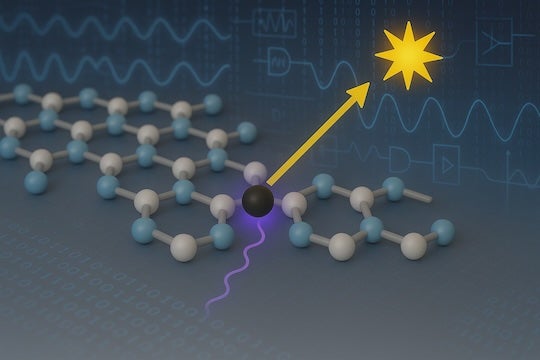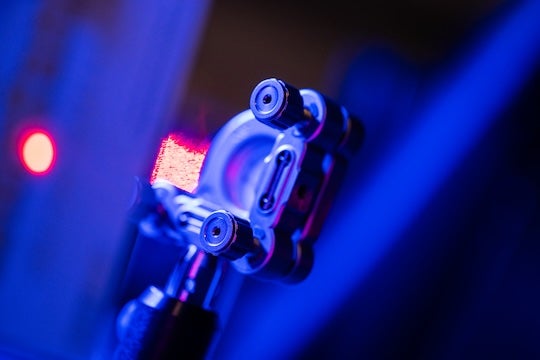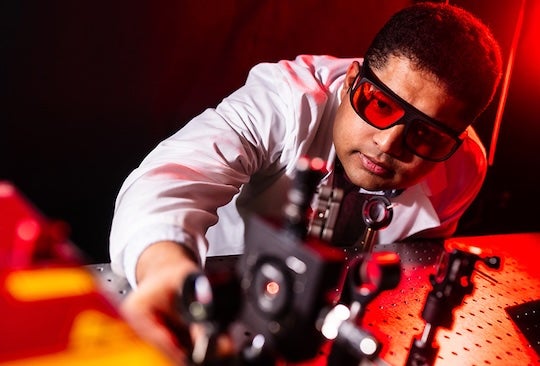Scientists across the world are working to make quantum technologies viable at scale ⎯ an achievement that requires a reliable way to generate qubits, or quantum bits, which are the fundamental units of information in quantum computing.

The task has so far remained elusive, but one of the materials that has garnered a lot of attention as a possible qubit platform is hexagonal boron nitride (h-BN), a 2D material that can host solid-state single-photon emitters (SPEs). Like the name indicates, SPEs are atomic structures in solid materials that can produce individual photons.
In a new study published in Science Advances, researchers at Rice University and collaborators at Oak Ridge National Laboratory and the University of Technology, Sydney report the first demonstration of low noise, room-temperature quantum emitters in h-BN made through a scalable growth technique.
The researchers used pulsed laser deposition (PLD) to synthesize h-BN films, deliberately adding carbon atoms during the deposition process. The carbon gets woven into the atomic lattice of h-BN in a way that generates so-called defects or irregularities. These defects are a feature rather than a flaw, functioning as robust and reliable SPEs.
“Our work demonstrates a scalable method to create high-performance SPEs in h-BN, offering a major step toward practical quantum light sources,” said Arka Chatterjee, a postdoctoral researcher in the lab of Rice electrical engineer Shengxi Huang. “This breakthrough paves the way for integrating quantum emitters into real-world photonic and quantum information systems.”

The equivalent to the qubit in classical computing is the bit, a contraction of “binary digit,” meaning it can have one of two values, either 1 or 0. The bit makes present computing and communication technologies possible, and the main way of embedding this binary state into physical systems in our current devices is electrical charge: In transistors and computing chips, for instance, the presence or absence of charge determines the logical value of the bit and serves to encode information. Reliable SPEs like those developed in this study are key to encoding and manipulating qubits in emerging quantum computing and communication platforms.
To work well, SPEs must perform reliably and uniformly, namely producing only a single photon of the same kind at a time ⎯ a tall order for structures that are commonly referred to as “defects” or “impurities.”
“We hypothesized that introducing carbon during the direct growth of h-BN films could create defect centers capable of emitting highly pure single photons at room temperature,” said Chatterjee, who is a first author on the study.
To test this hypothesis, the team turned to the lab of Rice materials scientist Pulickel Ajayan, where research scientist Abhijit Biswas used PLD to create centimeter-scale, carbon-doped h-BN thin films. The method offers several advantages, including PLD’s low-temperature requirements and the ability to integrate doping as part of a one-step synthesis process.

“Prior attempts to create stable h-BN emitters were limited by high-temperature synthesis or postprocessing steps that compromised purity and reproducibility,” said Huang, an associate professor of electrical and computer engineering and materials science and nanoengineering at Rice. “Our method overcomes these barriers by integrating doping and synthesis in a single, scalable step.”
Once the films were ready, the researchers tested their properties using photoluminescence spectroscopy, photon correlation measurements and theoretical modeling. These analyses revealed that the carbon-doped h-BN films had “exceptionally pure and stable SPEs, indicating near-ideal single-photon emission,” Chatterjee said.
“The emitters also exhibit high brightness, strong polarization and robust photostability during continuous operation,” he said, adding that first-principles calculations identified the carbon-induced defect structures as the origin of the emission.
The findings could enable the integration of SPEs into chip-based quantum devices and sensors, finally ushering in the much-anticipated transition to quantum-based technologies for communication, information processing and sensing.

“The combination of purity, scalability and operational stability sets a new benchmark and resolves long-standing challenges in the field,” Huang said.
The research was supported by the United States National Science Foundation (2230400, 1943895, 2246564), the Welch Foundation (C-2144), the Air Force Office of Scientific Research (FA9550-22-1-0408, FA9550-24-1-0004), Clarkson Aerospace Corporation, the U.S. Office of Naval Research Global (N62909-22-1-2028) and the Australian Research Council (CE200100010, FT220100053). The content herein is solely the responsibility of the authors and does not necessarily represent the official views of the funding organizations and institutions.
- Peer-reviewed paper:
-
Room-Temperature High-Purity Single Photon Emission from Carbon-Doped Boron Nitride Thin Films | Science Advances | DOI: 10.1126/sciadv.adv2899
Authors: Arka Chatterjee, Abhijit Biswas, Addis Fuhr, Tanguy Telier, Bobby Sumpter, Pulickel Ajayan, Igor Aharonovich and Shengxi Huang
https://www.science.org/doi/10.1126/sciadv.adv2899 - Access associated media files:
-
https://rice.box.com/s/swts93jtrigbdgw0vzdh1uj7221xujzh
Credit: Photos by Jeff Fitlow/Rice University

